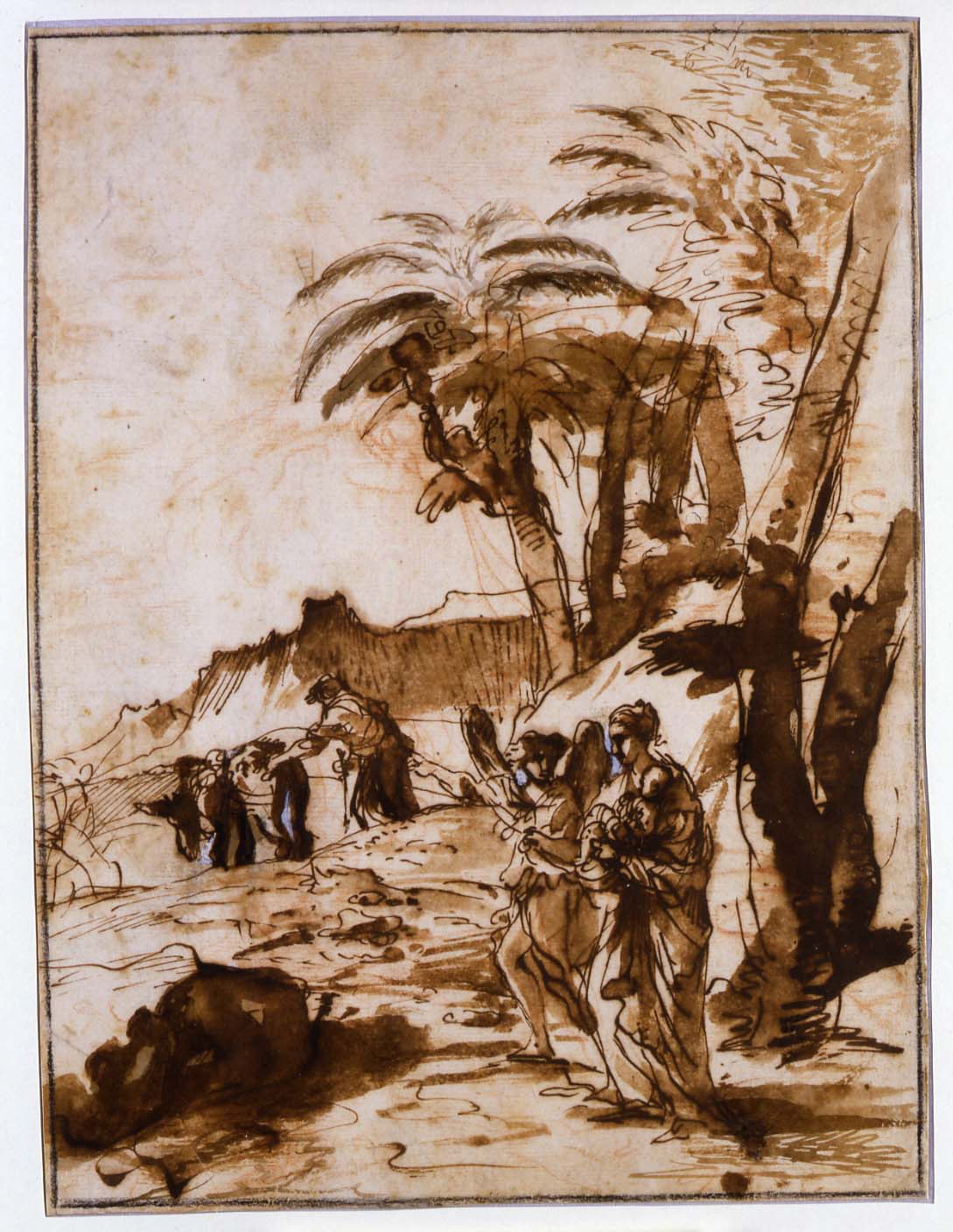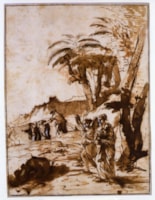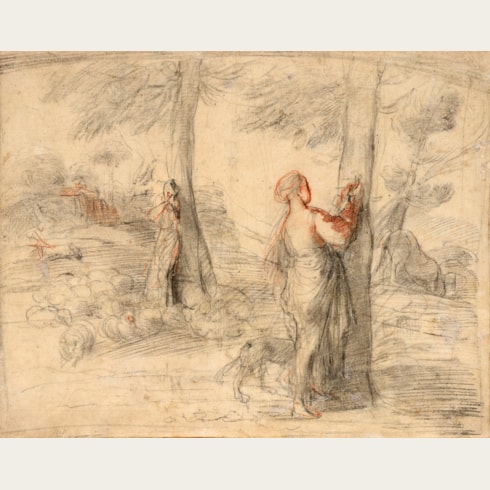Pier Francesco MOLA
(Coldrerio 1612 - Rome 1666)
Landscape with the Flight into Egypt
Sold
Pen and brown ink and brown wash, with touches of white heightening, over an underdrawing in red chalk.
Framing lines in black chalk, and the sheet backed.
266 x 197 mm. (10 1/2 x 7 3/4 in.)
Framing lines in black chalk, and the sheet backed.
266 x 197 mm. (10 1/2 x 7 3/4 in.)
The theme of the Flight into Egypt was one that Pier Francesco Mola treated in at least five paintings and several drawings, although to be more exact the subject depicted in his canvases was almost always the Rest on the Flight, with the Virgin and Child seated on the ground. While no painting by Mola of the Flight into Egypt (as distinguished from the Rest on the Flight) survives today, the subject occurs in several drawings by the artist, a common feature of which is a particular emphasis on the landscape setting. Drawings by Mola of The Flight into Egypt include sheets in the Musée des Beaux-Arts et d’Archéologie in Besançon, the Musée des Beaux-Arts in Lille, the Princeton Art Museum and the British Museum, while another example is in a private collection in Paris. Each of these drawings, however, differs from the present sheet in being horizontal in format. A drawing of The Flight into Egypt in the Louvre comes closer to the present sheet in orientation, although with significant differences in composition.
The present sheet is a particularly fine and fresh example of Mola’s spirited draughtsmanship. Among stylistically comparable drawings by Mola is a Rest on the Flight in the Teylers Museum in Haarlem.
The present sheet is a particularly fine and fresh example of Mola’s spirited draughtsmanship. Among stylistically comparable drawings by Mola is a Rest on the Flight in the Teylers Museum in Haarlem.
Born in the province of Ticino (today a canton of Switzerland), Pier Francesco Mola settled with his family in Rome at the age of four. He entered the Roman studio of Cavaliere d’Arpino at a young age, and later worked in Bologna as an assistant to Francesco Albani. To the influence of Arpino and Albani was added that of Pietro Testa, whom he met in Lucca in 1637, and Guercino, in whose Bolognese studio he may have spent time in the 1640’s. Of equal importance to the development of his artistic style were two long stays in Venice, between 1633 and 1640 and again from 1641 to 1647, after which Mola settled for good in Rome. His only signed and dated painting is the splendid Oriental Warrior of 1650, now in the Louvre. He joined the Accademia di San Luca in 1655, and the following year contributed to the redecoration of the Palazzo del Quirinale, painting a fresco of Joseph Greeting His Brothers on the end wall of the gallery of the palace. By 1658 he was working for Prince Camillo Pamphili, for whom he painted frescoes at the Pamphili palaces at Nettuno and Valmontone, although the latter was later overpainted by a fresco by Mattia Preti. Later patrons included Queen Christina of Sweden, while an invitation from Louis XIV to work in France was turned down on the grounds of the artist’s poor health. In 1662 Mola was elected principe of the Accademia di San Luca in Rome.
A large number of drawings by Mola survive today, the majority of which are in pen and brown ink and wash, with only a handful in red or black chalk. As Ann Sutherland Harris has noted of the artist, ‘Mola was one of the outstanding draughtsmen of the seventeenth century. He loved to draw, both because he took visual pleasure in the physical properties of all the media involved and because he responded to the spontaneity of the creative act that drawing afforded him. It is surely significant that a relatively large number of his drawings have been preserved (probably over two hundred)...while Mola’s surviving oeuvre as a painter active for at least thirty years is relatively small. Mola preferred the play of compositional ideas that he could indulge in quickly in a drawing to the demands of the more disciplined elaboration of those ideas in paint.’ Relatively few of Mola’s drawings may be identified as preparatory studies for his paintings. Many are unrelated to finished works and, in many cases, seem to have been done for the artist’s own pleasure; this is certainly true of a large number of caricature drawings. Significant groups of drawings by the artist are in the collections of the Museum Kunstpalast in Düsseldorf, the Teyler Museum in Haarlem, the Nationalmuseum in Stockholm, the Kupferstichkabinett in Berlin, the Louvre and the British Museum.





